FME Transformers: 2025.2
Overlays lines and areas, intersecting geometry and sharing attributes.

Typical Uses
- Splitting lines where they cross the boundary of a polygon
- Splitting polygons where crossed by lines
- Identifying which polygons contain or intersect lines
- Identifying lines that intersect or fall within areas
How does it work?
The LineOnAreaOverlayer compares lines and polygons, splitting geometry where they intersect.
It has two modes:
-
Split Lines With Areas: Lines are split where they intersect with a polygon boundary. Each resulting piece may receive the attributes of the area(s) it is contained in, and each containing area may receive the attributes of the line(s) that either fall within or intersect it (a spatial join). Features also receive a count of the number of overlaps encountered.
-
Split Areas With Lines: Areas are subdivided where they are split by lines or sets of lines. Only lines that split areas are considered for attribute merging and overlap counts.
Aggregates can either be deaggregated before processing or rejected.
Examples
In this example, we perform an overlay of bike path lines on neighborhood polygons. The source data looks like this, where the highlighted line is a bike path line feature that crosses from one neighborhood to another.
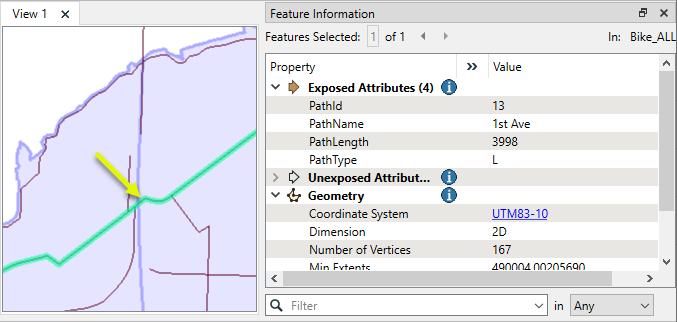
We want to accomplish two tasks in this example:
- splitting the lines where they intersect with a neighborhood boundary
- assigning new attributes (perform a spatial join)
- add the neighborhood attributes to the bike path
- add all of the contained bike path names to the neighborhood polygon as a list attribute
In the workspace, the bike paths are connected to the Line input port, and the neighborhoods are connected to the Area input port.

In the LineOnAreaOverlayer parameters dialog, we make the following selections:
- Mode: Split Lines With Areas
- Attribute Accumulation: Merge Overlaid(this is the default). This will merge the attributes from the features on to each other, which will add the neighborhood information to the segmented bike paths. However, it does not add multiple attribute values, and so we also:
- (Optional) Generate List On Output ‘Area’: This creates a list attribute on the output areas. By choosing Selected Attributes, and then PathName, only the bike path names will be added.

Viewing the output, we can see that the selected bike path has been split where it crosses the neighborhood boundary, and the neighborhood attributes for Mount Pleasant have been added to it.
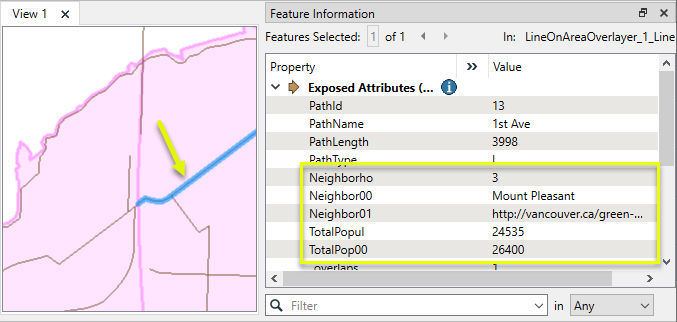
The containing neighborhood encountered 18 overlaps, and now has a list attribute containing the bike path names.
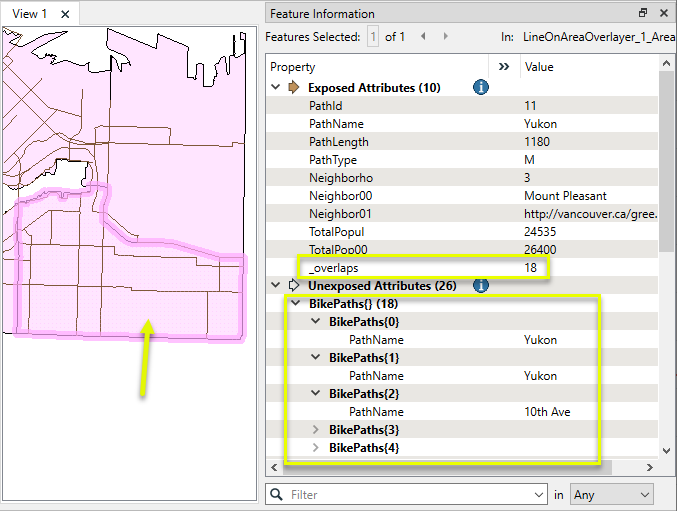
In this example, we have a single polygon covering the extent of Stanley Park.
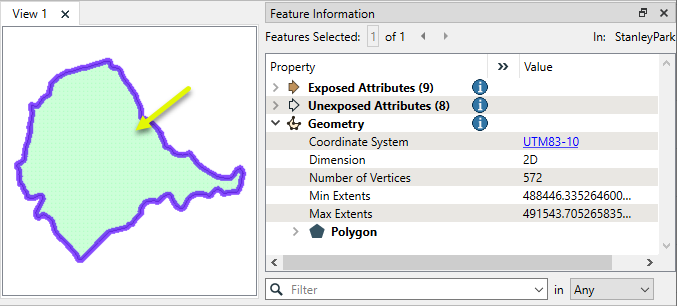
The park is crossed by numerous roads and pathways, and we want to divide the park polygon into pieces based on these lines.
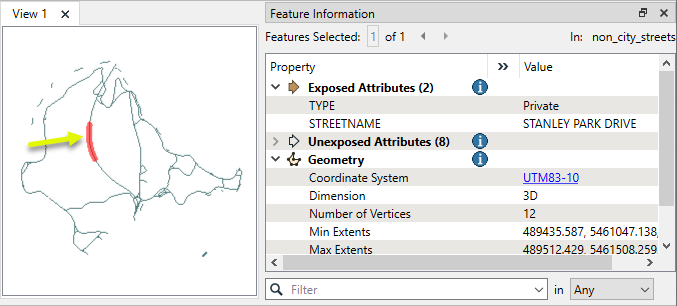
Both the park and the roads are routed into a LineOnAreaOverlayer.

In the parameters dialog, Mode is set to Split Areas With Lines.
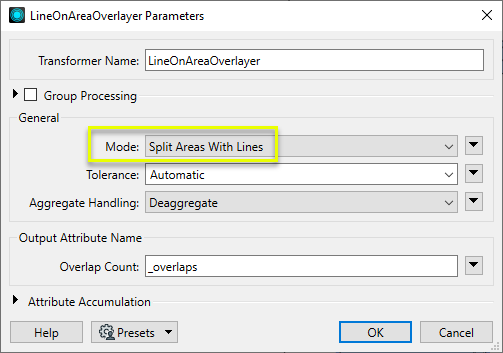
The lines are output unchanged, and the park polygon has been subdivided into smaller areas where the roads and paths cross it.

Usage Notes
Choosing a Spatial Transformer
Many transformers can assess spatial relationships and perform spatial joins - analyzing topology, merging attributes, and sometimes modifying geometry. Generally, choosing the one that is most specific to the task you need to accomplish will provide the optimal performance results. If there is more than one way to do it (which is frequently the case), time spent on performance testing alternate methods may be worthwhile.
To correctly analyze spatial relationships, all features should be in the same coordinate system. The Reprojector may be useful for reprojecting features within the workspace.
|
Transformer |
Can Merge Attributes |
Alters Geometry |
Counts Related Features |
Creates List |
Supported Types* |
Recommended For |
|---|---|---|---|---|---|---|
| SpatialFilter | Yes | No | No | No |
|
|
| SpatialRelator | Yes | No | Yes | Yes |
|
|
| AreaOnAreaOverlayer | Yes | Yes | Yes | Yes |
|
|
| LineOnAreaOverlayer | Yes | Yes | Yes | Yes |
|
|
| LineOnLineOverlayer | Yes | Yes | Yes | Yes |
|
|
| PointOnAreaOverlayer | Yes | No | Yes | Yes |
|
|
| PointOnLineOverlayer | Yes | Yes | Yes | Yes |
|
|
| PointOnPointOverlayer | Yes | No | Yes | Yes |
|
|
| Intersector | Yes | Yes | Yes | Yes |
|
|
| Clipper | Yes | Yes | No | No |
|
|
| NeighborFinder | Yes | In some cases | No | Yes |
|
|
| TopologyBuilder | Yes | Yes | No | Yes |
|
|
* Note that Curve includes Lines, Arcs, and Paths. Area includes Polygons, Donuts, and Ellipses.
Spatial analysis can be processing-intensive, particularly when a large number of features are involved. If you would like to tune the performance of your workspace, this is a good place to start.
When there are multiple ways to configure a workspace to reach the same goal, it is often best to choose the transformer most specifically suited to your task.
If performance is an issue in your workspace, look for alternative methods, guided by geometry.
Configuration
Input Ports
Curve features against which the areas will be compared.
Area features against which the curves will be compared.
Output Ports
When Mode is Split Lines With Areas, line features which have been split at area boundaries, with attributes added as specified in parameters.
When Mode is Split Areas With Lines, line geometry is unmodified.
When Mode is Split Lines With Areas, area features, with attributes added according to transformer parameter configuration. Geometry is unmodified.
When Mode is Split Areas With Lines, subdivided areas with attributes added as specified in parameters. Areas not split by Line features are passed through unchanged.
If a tolerance is specified, line features which were smaller than the tolerance value collapse to a point and are output to this port.
All non-curve features input to the Line input port and all non-area features input to the Area input port are output to this port.
Rejected features will have an fme_rejection_code attribute with one of the following values:
INVALID_LINE_GEOMETRY_TYPE
INVALID_LINE_GEOMETRY_VERTICES
INVALID_GEOMETRY_DEGENERATE
INVALID_POLYGON_GEOMETRY_TYPE
INVALID_POLYGON_GEOMETRY_VERTICES
INVALID_POLYGON_GEOMETRY_DEGENERATE
INVALID_GEOMETRY_NOT_FINITE
Rejected Feature Handling: can be set to either terminate the translation or continue running when it encounters a rejected feature. This setting is available both as a default FME option and as a workspace parameter.
Parameters
|
Group By |
The default behavior is to use the entire set of features as the group. This option allows you to select attributes that define which groups to form. | ||||
|
Complete Groups |
Select the point in processing at which groups are processed:
There are two typical reasons for using When Group Changes (Advanced) . The first is incoming data that is intended to be processed in groups (and is already so ordered). In this case, the structure dictates Group By usage - not performance considerations. The second possible reason is potential performance gains. Performance gains are most likely when the data is already sorted (or read using a SQL ORDER BY statement) since less work is required of FME. If the data needs ordering, it can be sorted in the workspace (though the added processing overhead may negate any gains). Sorting becomes more difficult according to the number of data streams. Multiple streams of data could be almost impossible to sort into the correct order, since all features matching a Group By value need to arrive before any features (of any feature type or dataset) belonging to the next group. In this case, using Group By with When All Features Received may be the equivalent and simpler approach. Note Multiple feature types and features from multiple datasets will not generally naturally occur in the correct order.
As with many scenarios, testing different approaches in your workspace with your data is the only definitive way to identify performance gains. |
|
Mode |
Split Lines With Areas: Default. Each input line is split at any area boundaries it intersects, and attributes may be shared between related lines and areas (spatial join). Split Areas With Lines: Each input area is split wherever it is subdivided by line input. Attributes may be shared between areas and their splitting lines (spatial join). |
|
Tolerance |
The minimum distance between geometries in 2D before they are considered equal, in ground units. If the tolerance is None, the geometries must be exactly identical to be considered equal. If the tolerance is Automatic, a tolerance will be automatically computed based on the location of the input geometries. Additionally, a custom tolerance may be used. |
|
Aggregate Handling |
Choose how aggregate geometries are to be handled. Deaggregate: Decompose aggregates into their individual components. With this setting, the transformer might output more features than were given as inputs. Reject: Do not process aggregates and output them via the <Rejected> port. |
|
Overlap Count |
Split Lines With Areas: The Overlap Count Attribute added to output linear features holds the number of area features that they were inside of. The Overlap Count Attribute added to output area features holds the number of linear features that they contained. Split Areas With Lines: The Overlap Count Attribute added to output linear features holds the number of area features that they bisected. The Overlap Count Attribute added to output area features holds the number of linear features by which they were bisected. Note that lines may intersect areas without bisecting them, and that these interactions are not recorded in this mode. |
If attributes on the incoming and original feature share the same name, but are not geometry attributes that start with fme_, then they are deemed conflicted.
|
Accumulation Mode |
Merge Overlaid: The original feature will retain all of its own un-conflicted attributes, and will additionally acquire any un-conflicted attributes that the overlaid feature has. This mode will handle conflicted attributes based on the Conflict Resolution parameter. Prefix Overlaid: The original feature will retain all of its own attributes. In addition, the original will acquire attributes reflecting the overlaid feature’s attributes, with the name prefixed with the Prefix parameter. Replace with Single Overlaid: The original feature will have all of its attributes removed, except geometry attributes that start with fme_. Then, all of the attributes from one (arbitrary) overlaid feature will be placed onto the original. |
|
Conflict Resolution |
Use Original: If a conflict occurs, the original values will be maintained. Use Overlaid: If a conflict occurs, the values of the overlaid features will be transferred onto the original. |
|
Prefix |
If the Accumulation Mode parameter is set to Prefix Overlaid, this value will prefix attributes that are being added to the original feature from the overlaid feature. |
Generate List on Output ‘Line’
When enabled, adds a list attribute to the Line output features, and the attributes of each area containing (or split by) an output line are added to that line's list.
Note that no intersections between area features are computed.
|
‘Line’ List Name |
Enter a name for the list attribute. Note List attributes are not accessible from the output schema in FME Workbench unless they are first processed using a transformer that operates on them, such as ListExploder or ListConcatenator. Alternatively, AttributeExposer can be used.
|
|
Add To 'Line' List |
All Attributes: All attributes will be added to the output Line features. Selected Attributes: Enables the Selected Attributes parameter, where specific attributes may be chosen for inclusion. |
|
Selected Attributes |
Enabled when Add To List is set to Selected Attributes. Specify the attributes you wish to be included. |
Generate List on Output ‘Area’
When enabled, adds a list attribute to the Area output features, and the attributes of each line contained by (or that split) an output area are added to that area's list.
Note that no intersections between area features are computed.
|
‘Area’ List Name |
Enter a name for the list attribute. Note List attributes are not accessible from the output schema in FME Workbench unless they are first processed using a transformer that operates on them, such as ListExploder or ListConcatenator. Alternatively, AttributeExposer can be used.
|
|
Add To 'Area' List |
All Attributes: All attributes will be added to the output Area features. Selected Attributes: Enables the Selected Attributes parameter, where specific attributes may be chosen for inclusion. |
|
Selected Attributes |
Enabled when Add To List is set to Selected Attributes. Specify the attributes you wish to be included. |
Editing Transformer Parameters
Transformer parameters can be set by directly entering values, using expressions, or referencing other elements in the workspace such as attribute values or user parameters. Various editors and context menus are available to assist. To see what is available, click  beside the applicable parameter.
beside the applicable parameter.
Defining Values
There are several ways to define a value for use in a Transformer. The simplest is to simply type in a value or string, which can include functions of various types such as attribute references, math and string functions, and workspace parameters.
Using the Text Editor
The Text Editor provides a convenient way to construct text strings (including regular expressions) from various data sources, such as attributes, parameters, and constants, where the result is used directly inside a parameter.
Using the Arithmetic Editor
The Arithmetic Editor provides a convenient way to construct math expressions from various data sources, such as attributes, parameters, and feature functions, where the result is used directly inside a parameter.
Conditional Values
Set values depending on one or more test conditions that either pass or fail.
Parameter Condition Definition Dialog
Content
Expressions and strings can include a number of functions, characters, parameters, and more.
When setting values - whether entered directly in a parameter or constructed using one of the editors - strings and expressions containing String, Math, Date/Time or FME Feature Functions will have those functions evaluated. Therefore, the names of these functions (in the form @<function_name>) should not be used as literal string values.
| These functions manipulate and format strings. | |
|
Special Characters |
A set of control characters is available in the Text Editor. |
| Math functions are available in both editors. | |
| Date/Time Functions | Date and time functions are available in the Text Editor. |
| These operators are available in the Arithmetic Editor. | |
| These return primarily feature-specific values. | |
| FME and workspace-specific parameters may be used. | |
| Creating and Modifying User Parameters | Create your own editable parameters. |
Table Tools
Transformers with table-style parameters have additional tools for populating and manipulating values.
|
Row Reordering
|
Enabled once you have clicked on a row item. Choices include:
|
|
Cut, Copy, and Paste
|
Enabled once you have clicked on a row item. Choices include:
Cut, copy, and paste may be used within a transformer, or between transformers. |
|
Filter
|
Start typing a string, and the matrix will only display rows matching those characters. Searches all columns. This only affects the display of attributes within the transformer - it does not alter which attributes are output. |
|
Import
|
Import populates the table with a set of new attributes read from a dataset. Specific application varies between transformers. |
|
Reset/Refresh
|
Generally resets the table to its initial state, and may provide additional options to remove invalid entries. Behavior varies between transformers. |
Note: Not all tools are available in all transformers.
For more information, see Transformer Parameter Menu Options.
Reference
|
Processing Behavior |
|
|
Feature Holding |
Yes |
| Dependencies | |
| Aliases | |
| History |
FME Online Resources
The FME Community and Support Center Knowledge Base have a wealth of information, including active forums with 35,000+ members and thousands of articles.
Search for all results about the LineOnAreaOverlayer on the FME Community.
Examples may contain information licensed under the Open Government Licence – Vancouver, Open Government Licence - British Columbia, and/or Open Government Licence – Canada.




